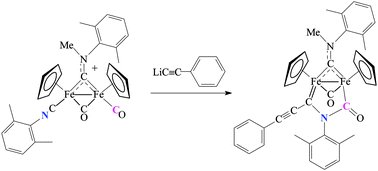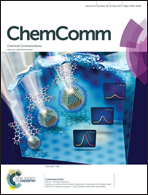Carbon monoxide–isocyanide coupling promoted by acetylide addition to a diiron complex†
Abstract
C–N bond formation involving carbon monoxide and isocyanide ligands is promoted by addition of a series of lithium acetylides to a diiron μ-aminocarbyne complex, i.e. [Fe2{μ-CN(Me)(Xyl)}(μ-CO)(CO)(CNXyl)(Cp)2][SO3CF3] (Xyl = 2,6-C6H3Me2). The reaction proceeds in three steps, i.e. (a) acetylide addition to the CO ligand, (b) acetylide migration to the isocyanide ligand, and (c) C–N coupling. The X-ray molecular structures of 1a and 1b comprise the first example of a κ(C,C′)-N-carbonyl-aminocarbene ligand.


 Please wait while we load your content...
Please wait while we load your content...